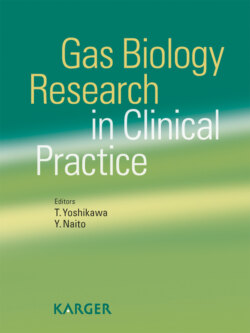Читать книгу Gas Biology Research in Clinical Practice - Группа авторов - Страница 23
На сайте Литреса книга снята с продажи.
Intestinal Obstruction
ОглавлениеThe patient with colonic obstruction or delayed small intestinal transit may frequently have bacterial overgrowth and increased breath H2 levels because the bacterium can contact with food residues for a longer time. An informative case with ileus after local peritonitis is demonstrated in figure 2 [28]. A 70-year-old woman presented with abdominal pain and distention. She has a past history of surgical treatment for peritonitis before 13 years. Plain abdominal radiograph showed a markedly dilated small bowel, with no dilatation of the colon. Fasting breath H2 concentration was 3 ppm at that time. This low levels of breath H2 before treatment might indicate that unabsorbed food residues did not reach the cecum due to small bowel obstruction. The patient was treated with the use of a gastric tube for drainage of gastric juice. Nutrition was provided intravenously. During the first 4 days, although small bowel gas increased gradually (fig. 1a, b), breath H2 concentrations remain less than 4 ppm (fig. 1). On the fifth day after admission, small bowel gas decreased and a small amount of colonic gas was demonstrated on the plain abdominal radiograph (fig. 1c). The breath H2 concentration at that time increased from 1 to 6 ppm and reduced again to the baseline the next day. This change in breath H2 level may possibly reflect the movement of intraluminal contents from the small intestine to the right colon. This value remained at a low level (1-2 ppm) from hospital days 5 through 8. Since intestinal gas was gradually reduced on radiographic imaging (fig. 1d), a liquid meal was supplied at noon on the ninth hospital day. The breath H2 concentration on the next day increased markedly to 19 ppm despite that she had no abdominal symptoms and intestinal gas was not increased on the plain abdominal radiograph (fig. 1e). This suggests malabsorption of a liquid meal by which unabsorbed carbohydrates reach the colon and is utilized by fermentation, resulting in increased breath H2 levels. Although diets progressed from liquids to solids as tolerated, breath H2 concentrations were decreased to 2 ppm 5 days after supplying meals. The patient did not complain of any abdominal symptoms during a routine progressive diet and intestinal gas concentration decreased continuously (fig. 1f, g). Digestive and absorptive function is considered to be restored gradually. Consecutive breath H2 analysis could provide important information on the movement of intestinal food residues or the presence of malabsorption after meals.
Fig. 1. Clinical course of a patient with ileus. Changes in breath hydrogen concentration and abdominal plain radiographs on representative dates are demonstrated.
Fig. 2. Comparison of volume passing through the digestive tract between gas and liquid plus solid contents.
